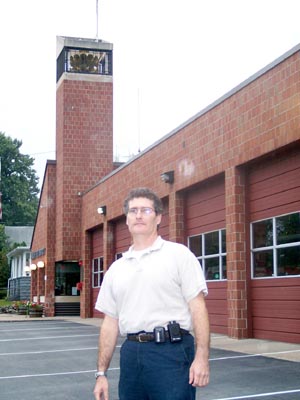
For most fire districts, the use of a siren is more for the benefit of the community and for nostalgia rather than as a way to alert firemen and EMS officials to a fire or other emergency. Over the past 20 years, firefighters’ equipment has moved rapidly forward from the scanners that would sit on a table in the corner of a fireman’s house and required volunteers to be within listening range at all times. “Before pagers became popular, the sirens were one way to alert the firefighters,” Chris Martin, public information officer for the Brockport Fire Department said. “Firefighters had home sets inside the house and if you weren’t in there within listening distance of the home set, the siren or whistle alerted the firemen.” At one time Brockport and many other area communities had a noon siren, the fire whistle and the civil defense siren. “Now that warning systems are so readily available on television and radio, the sirens aren’t as necessary,” Martin said. “There are those residents who think the siren should continue and those who don’t. I think it’s more of a nostalgia factor.” Stopping the sounding of the siren, Martin said, didn’t reduce the manpower or impact the department’s response time. According to Spencerport Fire Chief Chris Wood, the village fire department stops using its siren at 9 p.m. “In the past, the sirens used to go off for every call 24 hours a day,” he said. “We mainly utilize the siren as a way to alert residents and motorists that the trucks are being mobilized.” Mark Kalen, fire chief in Hilton, said today’s primary means for communication with firefighters is a voice or digital pager. “Each firefighter gets a voice pager and that is the way we alert both the fire and EMS people that we have a call and where it is,” he said. “The siren is more for the community and it runs from 8 a.m. to 8 p.m.” On a digital pager, a written message appears on the screen with all the information that the firefighter needs. Fire department members carry both digital and the voice pagers. The digital pagers get the earliest notification of a call but the voice pager allows the fire dispatcher to quickly update the information without typing in the additional updates. According to John Deserto, public relations officer (PIO) for the Hamlin Fire Department, “About two years ago, the fire department responded to a single complaint about the firehouse siren sounding at night which disturbed them. The department voted at that time to reprogram the siren to remain silent between 8 p.m. and 6 a.m.” The Commissioners of the Hamlin Fire District decided recently to return to the original program of sounding the alarm for each call, Deserto said. “There were several reasons for this. The firehouse siren is considered as a secondary means of notification for the firemen of a call, which is necessary for our Insurance Services Organization (ISO) rating,” he said. The ISO rating is based on the fire department’s capabilities and a good ISO will allow home owners in the community to save on their home-owner’s insurance. “The firehouse has its own backup generator so even during power outages, or if the paging system goes down, the siren can be used to alert firemen of a call,” Deserto said. “The firehouse siren is also connected to the building’s burglar alarm system and will sound if any unauthorized entry is made into the building.” Until about six years ago, Hilton had an in-house dispatcher who lived in the firehouse. “We went away from that and now have a full time day dispatcher from 8 a.m. to 5 p.m., a part timer from 5 to 10 p.m. Monday through Friday and then 911 answers calls after that,” Kalen said. The department also has an in-house dispatcher on weekends part time with Monroe County’s 911 system filling in the remainder of the time. It’s been about 10 years since residents in the Village of Brockport have heard the distinctive wail of a fire siren. “It was probably a combination of the fact that the siren was old and outdated and the utilization of new technologies for notifying the volunteers of calls that had us stopping the use of the siren,” Martin, Brockport Fire Department’s PIO said. “We were comfortable with the tone alert pagers and alpha alert pagers our volunteers have.” Hamlin’s fire call system background Prior to the early 1950s, if a person discovered a fire in Hamlin they called the Hamlin telephone operator who was located in Dollard’s Grocery Store. The operator would sound the firehouse siren to alert the firemen of the call. The first responding firemen would find out the location and nature of the call from the operator and write that information on a chalkboard in the firehouse. Around 1952, there was a very large fire at Eastman Kodak Company that required multiple fire departments to respond and, as a result of this event, Kodak gave money to the area fire departments to purchase base radios (larger more powerful radios that are kept in the firehouse) and mobile radios (smaller radios for the fire trucks). This system evolved to the voice paging system where firefighters wore individual pagers and listened to the information when they were “toned out.” Hamlin’s dispatcher is actually located in Brockport. This dispatcher also works for Brockport and Walker fire departments. Today’s firefighters in Hamlin are called out after someone makes a call to 9-1-1 and the operator fills out a “job card” with the information and location of the call. Instant Incident Routing forwards this to the Monroe County Fire Dispatcher and Brockport’s dispatcher for Hamlin via computer at the same time. The Brockport dispatcher acknowledges the call and it is immediately transmitted to the digital pagers. The dispatcher puts out the tones for Hamlin voice pagers and the audible siren is activated simultaneously. September 17, 2006 |
